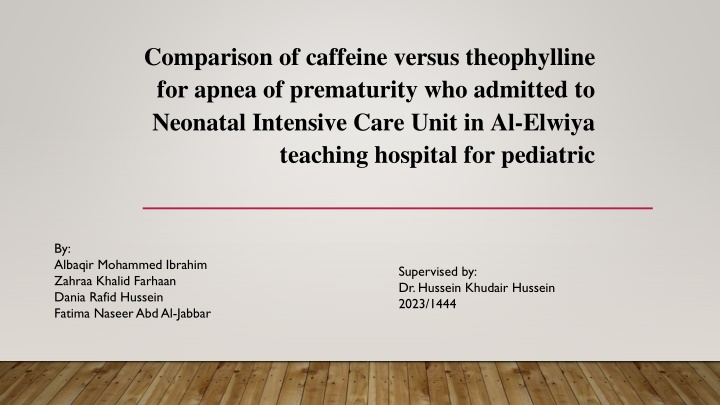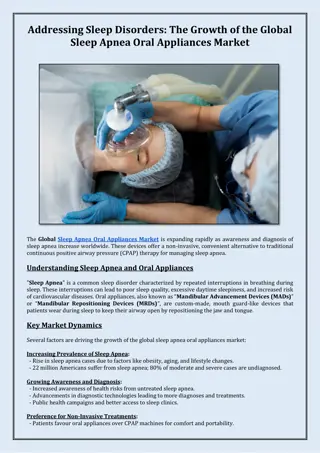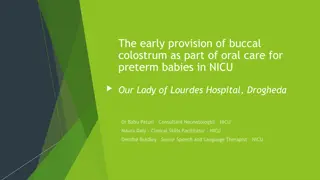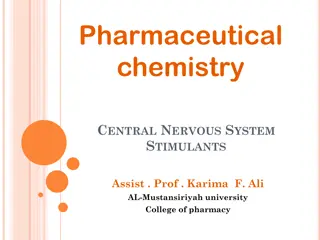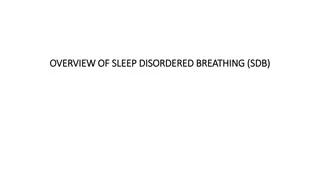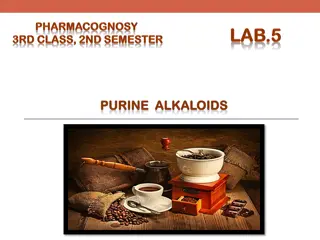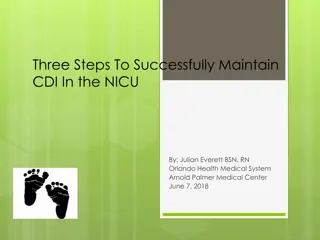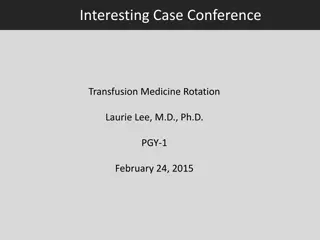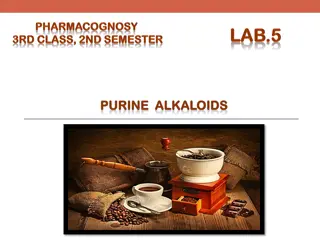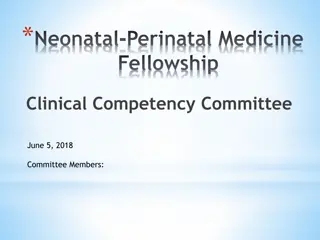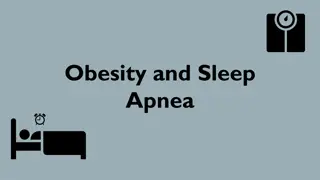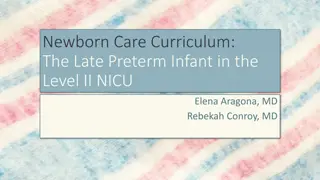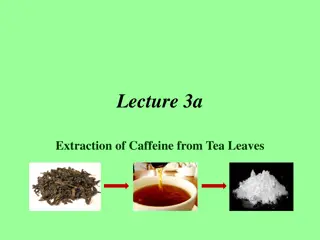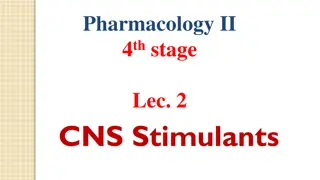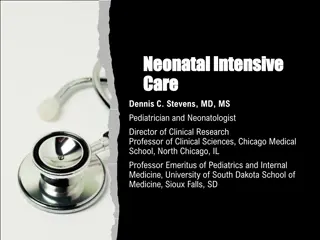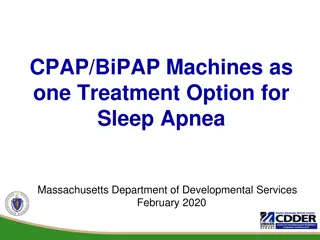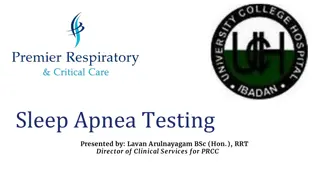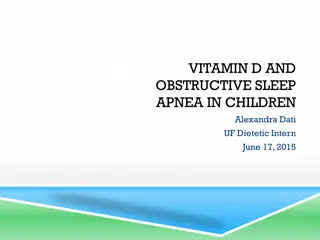Comparison of Caffeine vs Theophylline for Apnea of Prematurity in NICU
The study explores the benefits of caffeine and theophylline in managing apnea of prematurity in newborns admitted to Al-Elwiya teaching hospital. It discusses the incidence, subtypes, pathogenesis, ventilatory responses, neurotransmitters, and genetic variability associated with apnea in premature infants.
Download Presentation

Please find below an Image/Link to download the presentation.
The content on the website is provided AS IS for your information and personal use only. It may not be sold, licensed, or shared on other websites without obtaining consent from the author.If you encounter any issues during the download, it is possible that the publisher has removed the file from their server.
You are allowed to download the files provided on this website for personal or commercial use, subject to the condition that they are used lawfully. All files are the property of their respective owners.
The content on the website is provided AS IS for your information and personal use only. It may not be sold, licensed, or shared on other websites without obtaining consent from the author.
E N D
Presentation Transcript
Comparison of caffeine versus theophylline for apnea of prematurity who admitted to Neonatal Intensive Care Unit in Al-Elwiya teaching hospital for pediatric By: Albaqir Mohammed Ibrahim Zahraa Khalid Farhaan Dania Rafid Hussein Fatima Naseer Abd Al-Jabbar Supervised by: Dr. Hussein Khudair Hussein 2023/1444
Introduction The incidence of AOP is inversely correlated with gestational age and birth weight. Seven percent of neonates born at 34 to 35 weeks gestation, 15% at 32 to 33 weeks, 54% at 30 to 31 weeks [1], and nearly all infants born at <29 weeks gestation or <1,000 g exhibit AOP [2]. It is generally broken down into three subtypes: central, obstructive, or mixed [3]. Central apnea accounts for approximately 10% to 25% of all cases of apnea, with obstructive apnea accounting for 10% to 25% and mixed for 50% to 75%. In each individual infant, one of these subtypes tends to predominate [3].
Pathogenesis: AOP likely reflects a physiological rather than a pathological immature state of respiratory control. Fetal to neonatal transition : The postnatal rise in PaO2 effectively silences peripheral chemoreceptors, resulting in delayed onset of spontaneous breathing.
Ventilatory response to hypoxia: increase in respiratory rate and tidal volume that lasts for 1 2 min, followed by a late, sustained decline in spontaneous breathing that may last for several weeks This late decline in spontaneous breathing is termed hypoxic ventilatory depression Ventilatory response to hypercapnia: premature infants increase ventilation by prolonging the period of expiration, but not increasing breath frequency or overall tidal volume, leading to less minute ventilation than that seen in term infants. Ventilatory responses to laryngeal chemoreflex: Activation of the laryngeal mucosa in premature infants can lead to apnea, bradycardia, and hypotension
Neurotransmitters and apnea: adenosine receptors are expressed in GABA-containing neurons. The binding of adenosine to its receptor may be involved with the release of GABA and thus inhibit respiration leading to apnea Genetic variability and apnea: researchers found that the heritability of AOP was 87% among same-gender twins . These findings raise the possibility that AOP has an important genetic basis.
Consequences of AOP: Short-term consequences:In premature infants, desaturation and bradycardic episodes often occur along with apnea. Long-term consequences:It is difficult to prove a link between apnea and poor neurodevelopmental outcomes due to the possible coexistence of neurological injury in premature infants.
Methods: Study type: Setting and duration Duration: Inclusion criteria Exclusion criteria: Study population:
Study sample, sampling method, size of control group if present: Retrospective study, Available medical records of children admitted to the Neonatal Intensive Care Unit involving 2021 and 2022. Permission obtained from Al-kindy college of medicine by administrative order directed to Neonatal Intensive Care unit at Al- Elwiya hospital for pediatric to facilitate the task of obtaining the information.
Method of data collection : The Study involved 120 premature infants aged between (1-15) days old, but only 90 of them met our criteria. data were collected from patients records in Neonatal Intensive Care Unit, data include recording information regarding (gender, age, weight, the day of treatment start, delivery method, treatment used and the result) Age was divided into three categories Weight divided into three categories
Statistical methods: Data has been performed through EXCEL and SSPS program version 17 and. Qui square test applied looking for a more significant treatment between Caffeine and Theophylline. p value=0.05 was considered as cut off point for level of significance.
Variable Group Frequency Percent Results Gender Male 47 52.2 Female 43 47.8 Total 90 100.0 Age 1-5 days 63 70.0 6-10 days 24 26.7 Table 1: frequency distribution of studied cases according to study variables: 11-15 days 3 3.3 Total 90 100.0 1st day The day of treatment start 33 36.7 2nd day 25 27.8 3rd day 22 24.4 4th day 4 4.4 5th day 6 6.7 Total 90 100.0
Gender Weight Total Male Female Table 2: Weight distribution in study sample. Very low birth weight 5 10 15 Low birth weight 32 27 59 Normal birth weight 10 6 16 Total 47 43 90
Figure 1: Weight distribution in this study
Figure 2: Weight distribution in each day of treatment start
Variable Used medication Table 3: Association between the used medication and gender, age and results. Aminophylline Caffeine P value Gender Male 27 20 Female 18 25 0.140 Total 45 45 Age 1-5 days 33 30 6-10 days 12 12 11-15 days 0 3 0.208 Total 45 45 The result Improved 39 40 Death 4 4 Assignment RCN 2 1 0.885 Total 45 45
Discussion Study conducted by Natarajan G et al Maria S, et al In 2015 Jeong Ket al In a study conducted by Mohammed Set al Henderson-Smart DJ, et al Steer PA, et al and Markantonis SL
Conclusion Results of our study revealed that caffeine is a bit more effective than aminophylline in treatment of apnea of prematurity. The percentages of patients who admitted with a gestational age of (1-5) days were a bit superior. The association between the weight and the day of treatment start is significant that the number of patients with low birth weight were more than other groups.
Recommendation This a retrospective study ,so the needs for prospective study my change the results. This study highlight the importance of close following up the newborn , specially the preterm to prevent the short and long tem complications
